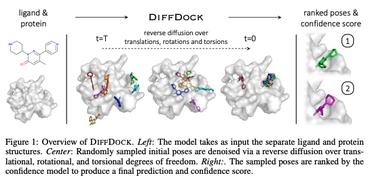Search Results for author: Bin Shao
Found 15 papers, 3 papers with code
Self-Consistency Training for Hamiltonian Prediction
no code implementations • 14 Mar 2024 • He Zhang, Chang Liu, Zun Wang, Xinran Wei, Siyuan Liu, Nanning Zheng, Bin Shao, Tie-Yan Liu
This merit addresses the data scarcity difficulty, and distinguishes the task from other property prediction formulations with unique benefits: (1) self-consistency training enables the model to be trained on a large amount of unlabeled data, hence substantially enhances generalization; (2) self-consistency training is more efficient than labeling data with DFT for supervised training, since it is an amortization of DFT calculation over a set of molecular structures.
Overcoming the Barrier of Orbital-Free Density Functional Theory for Molecular Systems Using Deep Learning
no code implementations • 28 Sep 2023 • He Zhang, Siyuan Liu, Jiacheng You, Chang Liu, Shuxin Zheng, Ziheng Lu, Tong Wang, Nanning Zheng, Bin Shao
Orbital-free density functional theory (OFDFT) is a quantum chemistry formulation that has a lower cost scaling than the prevailing Kohn-Sham DFT, which is increasingly desired for contemporary molecular research.
CLIPPING: Distilling CLIP-Based Models With a Student Base for Video-Language Retrieval
no code implementations • CVPR 2023 • Renjing Pei, Jianzhuang Liu, Weimian Li, Bin Shao, Songcen Xu, Peng Dai, Juwei Lu, Youliang Yan
Pre-training a vison-language model and then fine-tuning it on downstream tasks have become a popular paradigm.
PIDRo: Parallel Isomeric Attention with Dynamic Routing for Text-Video Retrieval
no code implementations • ICCV 2023 • Peiyan Guan, Renjing Pei, Bin Shao, Jianzhuang Liu, Weimian Li, Jiaxi Gu, Hang Xu, Songcen Xu, Youliang Yan, Edmund Y. Lam
The parallel isomeric attention module is used as the video encoder, which consists of two parallel branches modeling the spatial-temporal information of videos from both patch and frame levels.
 Ranked #3 on
Video Retrieval
on MSR-VTT-1kA
Ranked #3 on
Video Retrieval
on MSR-VTT-1kA
HiVLP: Hierarchical Interactive Video-Language Pre-Training
no code implementations • ICCV 2023 • Bin Shao, Jianzhuang Liu, Renjing Pei, Songcen Xu, Peng Dai, Juwei Lu, Weimian Li, Youliang Yan
However, compared to image-language pre-training, VLP has lagged far behind due to the lack of large amounts of video-text pairs.
An ensemble of VisNet, Transformer-M, and pretraining models for molecular property prediction in OGB Large-Scale Challenge @ NeurIPS 2022
no code implementations • 23 Nov 2022 • Yusong Wang, Shaoning Li, Zun Wang, Xinheng He, Bin Shao, Tie-Yan Liu, Tong Wang
In the technical report, we provide our solution for OGB-LSC 2022 Graph Regression Task.
Multi-View Substructure Learning for Drug-Drug Interaction Prediction
no code implementations • 28 Mar 2022 • Zimeng Li, Shichao Zhu, Bin Shao, Tie-Yan Liu, Xiangxiang Zeng, Tong Wang
Drug-drug interaction (DDI) prediction provides a drug combination strategy for systemically effective treatment.
Co-evolution Transformer for Protein Contact Prediction
1 code implementation • NeurIPS 2021 • He Zhang, Fusong Ju, Jianwei Zhu, Liang He, Bin Shao, Nanning Zheng, Tie-Yan Liu
These methods generally derive coevolutionary features by aggregating the learned residue representations from individual sequences with equal weights, which is inconsistent with the premise that residue co-evolutions are a reflection of collective covariation patterns of numerous homologous proteins.
Pre-training Co-evolutionary Protein Representation via A Pairwise Masked Language Model
no code implementations • 29 Oct 2021 • Liang He, Shizhuo Zhang, Lijun Wu, Huanhuan Xia, Fusong Ju, He Zhang, Siyuan Liu, Yingce Xia, Jianwei Zhu, Pan Deng, Bin Shao, Tao Qin, Tie-Yan Liu
The key problem in the protein sequence representation learning is to capture the co-evolutionary information reflected by the inter-residue co-variation in the sequences.
SE(3) Equivariant Graph Neural Networks with Complete Local Frames
1 code implementation • 26 Oct 2021 • Weitao Du, He Zhang, Yuanqi Du, Qi Meng, Wei Chen, Bin Shao, Tie-Yan Liu
In this paper, we propose a framework to construct SE(3) equivariant graph neural networks that can approximate the geometric quantities efficiently.
Improved Drug-target Interaction Prediction with Intermolecular Graph Transformer
no code implementations • 14 Oct 2021 • Siyuan Liu, Yusong Wang, Tong Wang, Yifan Deng, Liang He, Bin Shao, Jian Yin, Nanning Zheng, Tie-Yan Liu
The identification of active binding drugs for target proteins (termed as drug-target interaction prediction) is the key challenge in virtual screening, which plays an essential role in drug discovery.
Exploring the Regulatory Function of the N-terminal Domain of SARS-CoV-2 Spike Protein Through Molecular Dynamics Simulation
no code implementations • 6 Jan 2021 • Yao Li, Tong Wang, Juanrong Zhang, Bin Shao, Haipeng Gong, Yusong Wang, Siyuan Liu, Tie-Yan Liu
We performed molecular dynamics simulation on the S protein with a focus on the function of its N-terminal domains (NTDs).
Defending Model Inversion and Membership Inference Attacks via Prediction Purification
no code implementations • 8 May 2020 • Ziqi Yang, Bin Shao, Bohan Xuan, Ee-Chien Chang, Fan Zhang
Neural networks are susceptible to data inference attacks such as the model inversion attack and the membership inference attack, where the attacker could infer the reconstruction and the membership of a data sample from the confidence scores predicted by the target classifier.
SEEK: Segmented Embedding of Knowledge Graphs
1 code implementation • ACL 2020 • Wentao Xu, Shun Zheng, Liang He, Bin Shao, Jian Yin, Tie-Yan Liu
In recent years, knowledge graph embedding becomes a pretty hot research topic of artificial intelligence and plays increasingly vital roles in various downstream applications, such as recommendation and question answering.
 Ranked #1 on
Link Prediction
on YAGO37
Ranked #1 on
Link Prediction
on YAGO37
Hallucinating very low-resolution and obscured face images
no code implementations • 12 Nov 2018 • Lianping Yang, Bin Shao, Ting Sun, Song Ding, Xiangde Zhang
The inpainting network restores the low-resolution(LR) obscured face images.







